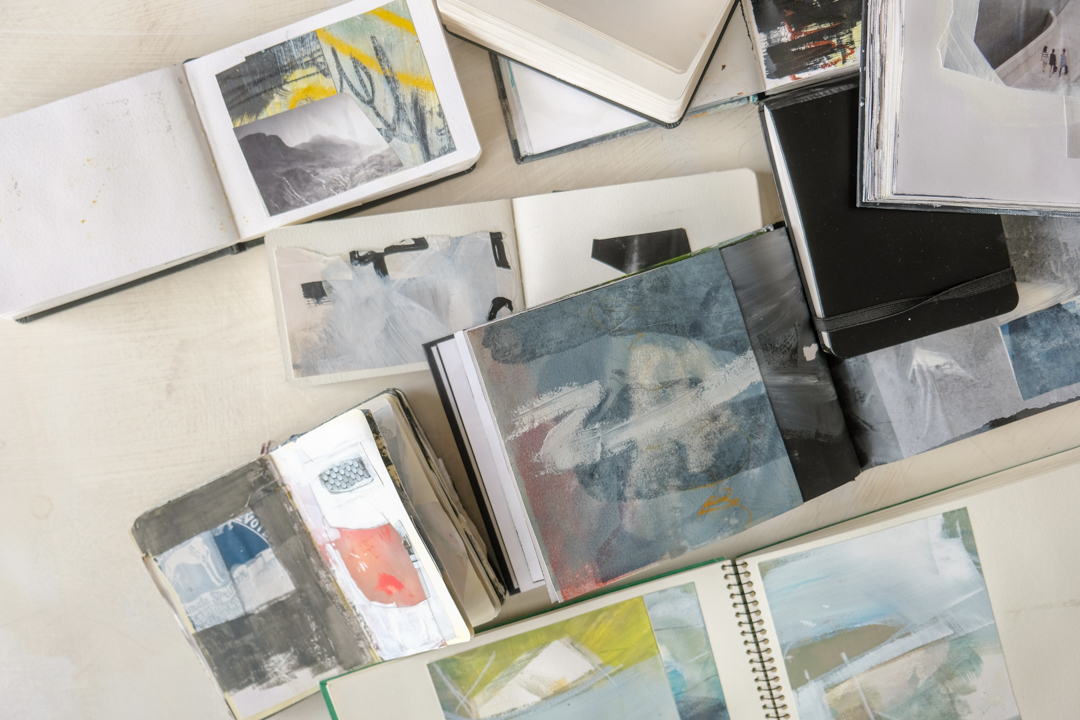OPENING UP THE NO-SKETCH SKETCHBOOKS
I can remember standing, awestruck, in the Brooklyn Art Library on a trip to New York a few years ago, surrounded by the tens of thousands of journals that make up The Sketchbook Project. I felt inspired and intimidated in equal measure by the breadth of creativity that flanked an entire wall, shelves floor to ceiling. At this point (before my rebirth as An Artist ) I assumed that sketchbooks had to be sketched in, and used as reference to make larger paintings, and kept small and neat.
I’d see people on a train or cliff top, in a few swift strokes capturing an essence of a character or a view, in their pocket sized moleskine, that went everywhere with them (or so I believed.) And so my supply of pristine sketchbooks (I’ve never had a problem with purchasing new, virgin white, expensively bound journals) stayed firmly closed.

And yet at my first solo show in Devon in 2017 the sketchbooks I put out on display (I’d finally overcome my fear of the sketchbook) were the most popular exhibit. Thumbed through, pored over, discussed, photographed. Viewers recognised that the artist’s sketchbook is a candid, sometimes raw behind-the-scenes peek at the artist’s life, often playful and sometimes even (possibly) reflective of the deepest, darkest workings of her mind.
What had changed?


My painting practice began in sketchbooks, although at that point I called them art journals. Because I didn’t sketch in them, you see?!
I wrote, painted and collaged. I used ink, glue, crayon and paint , and rarely pencil. I spilled my innermost thoughts and painted over them. The journals, and the private thoughts, stayed closed, the pages bulging and sticking deliciously together.



What changed was that I allowed myself to write my own definition of what a sketchbook/ (visual journal/ inspiration book/ workbook/ scrapbook) is – and it encompasses some or any or all of the following, in no order at all.
•Somewhere to collect inspiration from many and all sources
•A way of processing ideas, playing with ways to articulate and express those ideas in art
•Organising unedited thoughts
•A container for notes about studio practice, quotes, titles for paintings,
•Reminders (did you know your brain keeps info for an average of only 3 minutes, unless it’s reinforced for example by writing it down?)
•An intimate canvas for play
•A means of warming up the creative muscles
•A way of using up old stuff and discovering new mark making techniques/ colour or material combinations/ compositions in the process.
•A low risk opportunity to make mistakes
•A chance to try new ideas without expectation or judgement
•Somewhere to develop ideas and practice the skills of observation
•A record of progress
•A travel journal
•A repository of colour swatches and experiments in mixing and combining
•A place to try out new materials and combinations and experiments in composition
•Somewhere to encourage connection between ideas and
facilitate deeper thinking
•Somewhere to turn to when I feel blocked
•A means of grounding myself before beginning works on canvas or larger projects
•A way to practice techniques and encourage a regular creative habit


For the first time recently I’ve used a large sketchbook to collate ideas to help plan- or at least, brainstorm some ideas – for a specific new body of work. It pulls together a motley collection of small, rough works on paper that I’ve done as warm-ups, on workshops, scraps using left over paint, mark making experiments, collages, snippets of writing (my own and quotes from others) photographs, magazine clippings, and so on. (I still use my books more as a scrapbook to stick things into, rather than work directly onto the pages- usually.) The only thing each element has in common is that I feel intuitively they might be able to inform the final paintings in some way. it is helping a theme emerge. As the sketchbook develops I anticipate I’ll be working on compositions, titles, and colour palettes. Or maybe I’ll do this directly on the canvas, as I’ve tended to do up to now. It’s an interesting experiment.

Sketchbookery is now a solid part of my art life. Working in a book feels low-risk if I’m feeling vulnerable, or daring if I’m in a rebellious mood. It’s an early morning warm-up or late night comfort blanket. I can take a book in my bag with some scissors and glue if I go away, and I don’t feel I’m leaving a part of myself behind.

I still don’t sketch. I’ve learnt that sketchbooks are as individual as their artist companions. I do it my own way. My visual journals are what got me painting in the first place . Years later I can see that my recent sketchbooks like my original journals, although they look quite different, are a platform for me to absorb, filter, process and cultivate my thoughts and ideas.

Each page may be an end in itself, the process being the point. Others may be jumping off points, kickstarters to larger pieces. Some pages are a lesson in patience, failure, or the joy of serendipitous connection.

The lesson here is that there is no right or wrong way to sketchbook. The only rule is that you have to open those pristine journals up , crack the spines, spill the ink, spill your heart, and make a mark.





